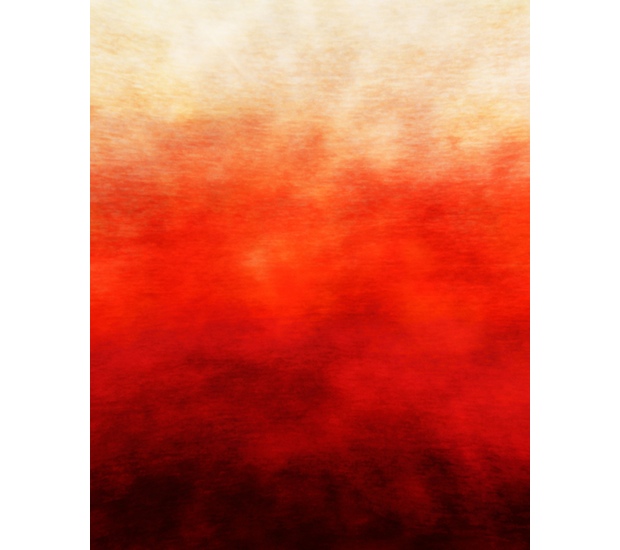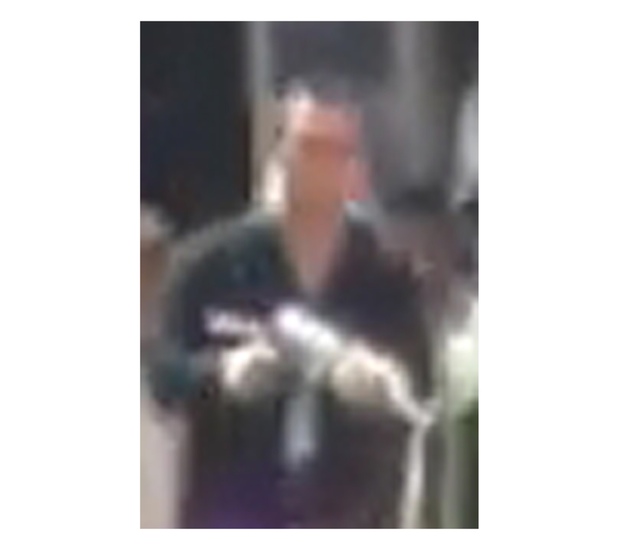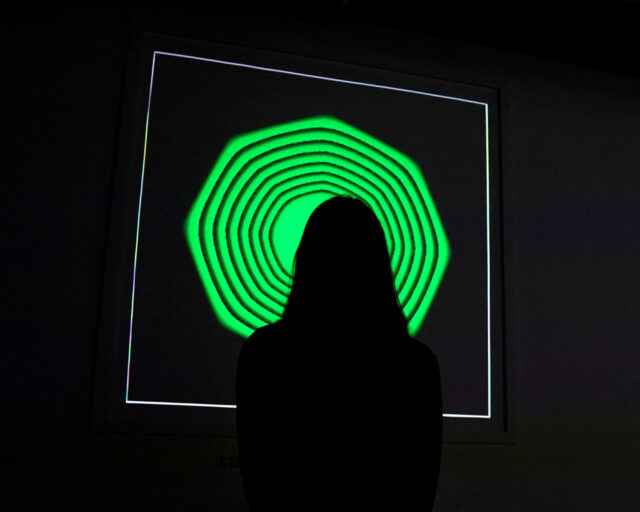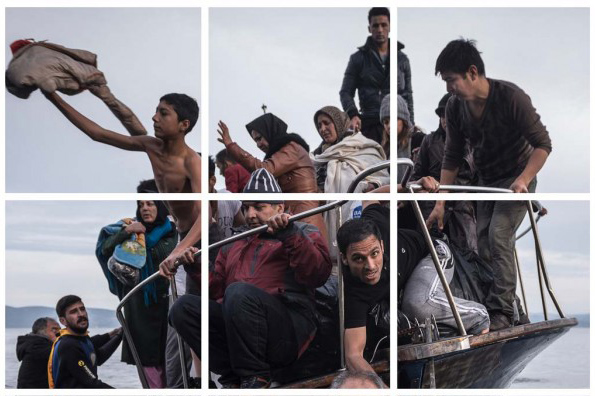Picking Up the Pieces
Implicit in the purposefully vague title of the third International Center of Photography triennial, A Different Kind of Order, is a sense that some substantial schism has recently taken place, within photography as much as within broader society, and has upset our normal ways of thinking and doing. It begs the question: how? Though the exhibition’s curators—Kristen Lubben, Christopher Phillips, Carol Squiers, and Joanna Lehan—have provided myriad provisional answers by way of an eclectic collection of work produced by a largely interesting assortment of artists, it is telling that the show’s working title was less sanguine: Chaos.
Indeed, chaos rears its head frequently in the show, most notably in the form of strong works that allude to various political and environmental crises. Chief among these is Thomas Hirschhorn’s deeply disquieting, deceptively simple Touching Reality (2012), a looping five-minute video of a woman’s hand scrolling through iPad images that depict the battered, broken bodies of people killed in recent conflicts. These images, which are readily available on the Internet but rarely, if ever, surface in the mainstream media, are unspeakably horrific: brain matter oozing out of shattered skulls, slick viscera flopped on dusty pavement, severed heads decorated with macabre tassels of tendon, vein, and bone. They form a relentless, stomach-churning parade of death and suffering. Incongruously, however, the hand guiding us through this grizzly landscape is slender, pretty, and well manicured. It caresses the glossy surface of the space-age tablet gingerly, lingering on certain images or zooming in on details both terrible and banal, as if conducting a virtual forensic investigation. Just as often, it blithely flips past gruesome scenes as if it belonged to a distracted teenager idly cruising her Instragram feed. In this, the piece vaults past mere agitprop to become a metaphor for our own state of digitized distraction and desensitization, providing a holistic dissection of a particularly fraught aspect of contemporary image politics through an elegant economy of means.
Videos by Hito Steyerl and Rabih Mroué also provide nuanced looks at the intersection of politics and image culture. Steyerl, for her part, presents a pair of videos concerning the death of her friend Andrea Wolf at the hands of the Turkish government, a result of her participation in the PKK, a Kurdish separatist movement. The best, and most well-known, of these videos, November (2004), tracks Wolf’s transmogrification from the ersatz revolutionary that she often played in her and Steyerl’s homemade B-movies into the real thing, and ends with her image’s immortalization by way of protest placards commemorating her martyrdom. The accompanying two-channel video, Abstract (2012), is something of a contemporary take on Brecht’s famous observation about a photograph of a factory revealing nothing of social and political relations that undergird it. It pairs scenes of Steyerl photographing the Berlin outpost of American defense contractor Lockheed Martin with those showing her and a friend being guided around a placid patch of mountainous terrain where Wolf and a group of her compatriots were bombarded with Lockheed-manufactured Hellfire missiles. Mroué’s contribution, the video version of a performance lecture entitled The Pixilated Revolution (2013), operates in a similar vein: the artist delivers a complexly poetic “non-academic lecture” on citizen journalism during the current Syrian civil war, inspired by a friend’s observation that in the absence of official media coverage “the Syrian people are filming their own death.”

Trevor Paglen, The Fence (Lake Kickapoo, Texas), 2010. Collection New School Art Collection. Courtesy the artist; Altman Siegel, San Francisco; Metro Pictures, New York; and Galerie Thomas Zander, Cologne.
Other notable works in the show point to contemporary chaos and upheaval but mostly shy away from self-reflexivity. These include a collection of striking photograms by Shimpei Takeda that resemble rudimentary images of the cosmos, exposed by way of contact with radioactive soil from areas surrounding the Fukushima nuclear disaster; Gideon Mendel’s affecting though slightly stagey images of victims of massive flooding precipitated by manmade climate change; and Lucas Foglia’s more lyrically inflected photojournalistic studies of American secular and religious intentional communities whose pastoralism, in this context, is tinged with an air of the post-apocalyptic.
Of all the politically inflected pieces in the show, however, only two bodies of work—by Mishka Henner and Trevor Paglen—suggest what one aspect of the exhibition’s titular “different order” might be. Both examine the shadowy doings of government. Henner appropriates sections of Google Maps that have been censored in an inadvertently artful, kaleidoscopic manner to conceal sensitive sites. Paglen presents a pair of sublime, horizonless skyscapes intruded upon by the nearly imperceptible presence of unmanned drones. A companion video, Drone Vision (2010), consists of an eerie snippet of drone’s-eye-view footage intercepted from a communications satellite, and an image, created in collaboration with an amateur radio astronomer, of the vast United States government radar system known as “The Fence,” designed to detect foreign spacecraft and intercontinental ballistic missiles. While chaos runs roughshod over the tender earth, these works intimate a new order being instilled from above: a global, high-tech network of surveillance and control whose construction within the United States was aptly characterized by NSA whistleblower Edward Snowden as the foundation of “turnkey tyranny”—an architecture that, once in place, could usher in an Orwellian future with a mere flick of a switch.
This, however, is only half the story. The triennial’s secondary, more parochial concern lies not with the fate of the world, but with the medium of photography itself. Of course, taken in the context of an institution whose very existence is predicated on medium specificity, this concern’s parochialism is relative.
Photography, in its traditional incarnations, is at a crossroads. Perhaps paradoxically, at the moment of the medium’s greatest profusion—2012 statistics place the number of photos uploaded to Facebook alone at three hundred million per day—it has begun appearing to teeter on brink of exhaustion. Everything, it often seems, has already been catalogued in the Internet’s vast Borgesian library of images, or soon will be. This sense, whether true or not, appears to have provoked a number of the artists in the show to either high-tail it towards analog processes and hybrid forms (Sam Falls’s ubiquitous fabric fades, the ones here made by wrapping hand-dyed bed sheets around boulders in Joshua Tree and leaving them to blanch in the desert sun) or to engage in self-reflexive analysis of the rapidly shifting image culture in which they find themselves (Oliver Laric’s Versions videos, widely known in Europe, which examine the ontologically destabilizing nature of copies, bootlegs, and remixes).
Tellingly, neither Falls’s fades nor Laric’s videos fit comfortably in the traditional category of “photography,” an assessment that could be made about many of the best works in the show. This, of course, is to the curators’ credit, but it raises a serious question for ICP and institutions like it around the world: with the medium chafing against its historical constraints and its boundaries becoming increasingly blurred, isn’t it time, once and for all, to tear down the barriers that have kept photography from expanding its territory? In short: is the “photography museum” necessary?
A Different Kind of Order remains on view at the International Center of Photography through September 22.


























